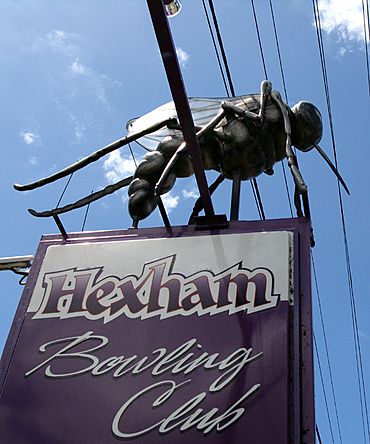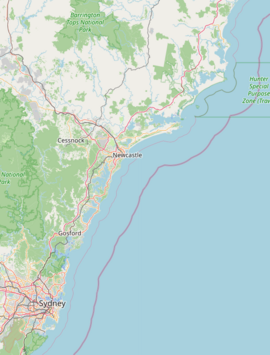Hexham, New South Wales facts for kids
Quick facts for kids HexhamNewcastle, New South Wales |
|||||||||||||||
|---|---|---|---|---|---|---|---|---|---|---|---|---|---|---|---|

"Ozzie the Mozzie" at Hexham Bowling Club
|
|||||||||||||||
| • Density | 8.1/km2 (21/sq mi) | ||||||||||||||
| Established | 1820s | ||||||||||||||
| Postcode(s) | 2322 | ||||||||||||||
| Elevation | 2 m (7 ft) | ||||||||||||||
| Area | 18.7 km2 (7.2 sq mi) | ||||||||||||||
| Time zone | AEST (UTC+10) | ||||||||||||||
| • Summer (DST) | AEDT (UTC+11) | ||||||||||||||
| Location | |||||||||||||||
| LGA(s) | City of Newcastle | ||||||||||||||
| Region | Hunter | ||||||||||||||
| County | Northumberland | ||||||||||||||
| Parish | Hexham | ||||||||||||||
| State electorate(s) |
|
||||||||||||||
| Federal Division(s) | Newcastle | ||||||||||||||
|
|||||||||||||||
|
|||||||||||||||
Hexham is a suburb of Newcastle, a city in New South Wales, Australia. It is located about 15 kilometres (9.3 mi) inland from the centre of Newcastle. Hexham sits on the bank of the Hunter River.
Contents
History of Hexham
Hexham was first settled in the 1820s. The land was given to Edward Sparke. The town was named after Hexham, a market town in England. Both Hexham, Australia, and Hexham, England, are close to a city called Newcastle. Many coal miners from England moved to New South Wales around this time.
Hexham's history is linked to nearby places. These include Tarro (which was once called Upper Hexham), Ash Island, Tomago, and Minmi.
Geography and Landscape
Hexham covers an area of about 18.7 square kilometres (7.2 sq mi). It stretches about 6.7 kilometres (4.2 mi) from north to south. It is also about 6 kilometres (3.7 mi) from east to west. The Hunter River borders Hexham to the east. Ironbark Creek borders it to the south.
Most of Hexham is made up of swampland and floodplains. These areas are not used for building. Almost all the buildings are along the Pacific Highway. This narrow area is mainly for roads and factories. There are only three small areas where people live. Hexham Park is located on Maitland Road. It has a cricket pitch, a rugby field, and other sports facilities.
Getting Around Hexham
Roads and Highways
Hexham is an important meeting point for major roads. The Pacific Highway (leading to Brisbane) and the New England Highway meet here. It is also close to the start of the Pacific Motorway.
Years ago, the Hunter Valley Dairy Co-operative built a milkbar here. It was the first one for their Oak milk brand. This was because Hexham was a great spot for travellers. Today, the site is owned by Brancourts, another dairy company. People still call it the "old Oak site."
Hexham was a good place to cross the Hunter River. In the 1800s, a punt (a type of ferry) was used. Later, a steam punt carried cars. As more cars used the road, Hexham became very busy. So, a bridge was planned in the 1930s. The first two-lane bridge opened in 1952. It was a steel bridge with a part that could lift up. This allowed ships to pass underneath.
By the 1970s, this bridge also became too busy. So, a second bridge was built in 1987. This new concrete bridge carries all traffic going north. The first bridge now carries only traffic going south.
Trains and Railways
Hexham has its own train station. It is on the Main Northern railway line. Trains run hourly between Newcastle and Maitland/Telarah.
Hexham was also the end point for the Richmond Vale railway line. This was a private railway that carried coal from Minmi and Stockrington. Coal was loaded onto ships at the Hexham wharf. This railway line closed in 1987.
Shipping and River Transport
Hexham was once an important river port. It was even known as Port Hunter. In the past, people travelling from Newcastle to Maitland could take a boat to Hexham. From there, they would travel by road to Maitland. This was often faster than following the winding river.
Coal loading began at Hexham around 1850. Coal was brought by train from mines and loaded onto ships. One company, J & A Brown, had a large rail yard here. They used it to move coal trains onto the government rail line. The Hexham Coal Washery, which cleaned coal, opened in 1953. The last ship to load coal at Hexham was in May 1988.
Another wharf was located upstream. It was used by different coal companies over the years. They built large silos to store coal and conveyors to load it onto ships quickly. This loader closed in 1972.
The ships that served Hexham were often small. They were called "60 milers" because they travelled about 60 miles (97 km) to Sydney. They carried coal for gas-making or to coal depots. Sometimes, these ships would get stuck in the shallow water near Hexham.
Milk was also transported by small boats. This happened after the Hunter Valley Dairy Co-operative factory opened in Hexham in 1927.
Industries and Businesses
Hexham's location has always made it a key place for businesses. It has easy access to river, road, and rail transport.
- Early Industries: It started with farming by the Sparke family. Because it was a crossroads, hotels soon opened. There were three hotels in the 1800s.
- Coal and Dairy: Later, Hexham became important for loading coal. Coal washeries (places to clean coal) and engineering workshops were also built. The Hunter Valley Dairy Co-operative opened its factory here in 1927. This is where the famous Oak milk brand began. Today, Brancourts Dairy owns and runs the factory.
- Modern Businesses: Hexham's central spot means it has petrol stations and fast food places. There are also warehouses and sales yards for large vehicles and caravans.
- Community: The Hexham Bowling Club offers fun activities for local people and visitors. The Free Church of Tonga is also located on Old Maitland Road.
Population of Hexham
In the 2021 census, Hexham had 157 people living there. The average age of people in Hexham was 35 years old. This is a bit younger than the national average of 38 years. About 84% of the people living in Hexham were born in Australia.
Hexham's Famous Mosquitoes
The area around Hexham is known for a type of mosquito called Ochlerotatus alternans. These mosquitoes are famous for being very large and fierce! People call them "Hexham Greys."
The most famous Hexham Grey is "Ozzie the Mozzie." This is a giant model of a mosquito. It sits on top of the Hexham Bowling Club sign. The club's "retired" bowlers are even called the "Hexham Greys." The current "Ozzie" was put up in 2005.
Images for kids




